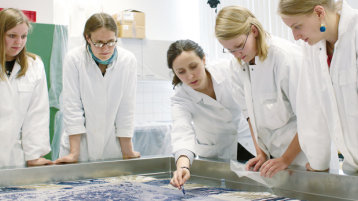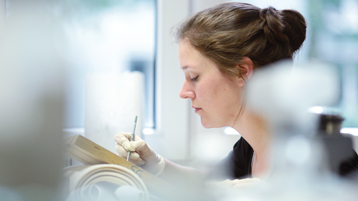Conservation of fluid preserved specimens

This master thesis was dedicated in the development and implementation of a conservation concept for selected fluid preserved specimens of the Ruhr Museum Foundation. The aim was to treat a part of the collection of the now closed Fuhlrott Museum in Wuppertal, considering the material, technological and ethical aspects.
At a glance
| Kategorie | Beschreibung |
|---|---|
| Student project | Development and implementation of a conservation concept on selected fluid preserved specimens of the Fuhlrott Collection at the Ruhr Museum Foundation. |
| Supervisors | Prof. Dr. Ester Simoes B. Ferreira |
| Dipl.-Rest. (FH) M.A. Melanie Dropmann | |
| Student | Fabian Neisskenwirth |
| CICS department | Natural Sciences |
| Project partners | Ruhr Museum, Essen |
| Duration | 2019 - 2021 |
Picture gallery
 0 / 0
0 / 0
Schematic of a fluid preserved specimen in excellent condition, exemplified by an educational specimen from the Fuhlrott collection. (Image: TH Köln - CICS - Fabian Neisskenwirth)
 0 / 0
0 / 0
„Raman-Bundle“ from Ocean Insight (top left) and fluid preserved specimen with probe (top right). Raman spectra (bottom) of ethanol (blue line) and the measured preservation fluid in the jar (green line) in comparison. The characteristic bands of the spectra are identical. (Image: TH Köln - CICS - Fabian Neisskenwirth)
 0 / 0
0 / 0
Excerpt from a catalog (right) from the teaching aids of the company "Linnaea naturhist. Institut - Berlin" from the year 1892 (Image: MfN, HBSB, ZM S II Linnaea). The same fluid preserved specimen and direct reference from the collection of the Schulhistorisches Museum der Stadt Wuppertal (center) and one of the treated specimens from the Fuhlrott collection in the Ruhr Museum (right). This comparison helped for dating and proofs reconditioning treatments made on the object. (Image: TH Köln - CICS - Fabian Neisskenwirth)
 0 / 0
0 / 0
Tools for "minimally invasive" refilling of evaporated preservation fluid of the jars. Cannula (0.4 mm) with overlaid PTFE tube (top right); cannula and syringe to withdraw preservation fluid (bottom left); cannula (1.2 mm) to guide the PTFE tube (bottom right). Topping up procedure of the first treated fluid preserved specimens with adapted infusion system (right). (Image: TH Köln - CICS - Fabian Neisskenwirth)
Although fluid preserved specimens as part of natural history collections have a rather functional role as vouchers, those made for display purposes are characterized by how they are displayed.
During this project, a conservation concept for fluid preserved specimens from the natural history collection of the Ruhr Museum in Essen was developed to take into account the various material and non-material values of such collections. The heterogeneous state of preservation and the incomplete documentation of the preparations posed a particular challenge.
Material analysis was carried out as part of the documentation process. By means of Raman spectroscopy a noninvasive analysis of the preservation fluid could be performed through the glass. The use of a portable instrument provided by the company Ocean Insight enabled the analysis. Numerous comparisons with other collections of fluid preserved specimens within Germany were particularly helpful to characterise and document the educational specimens within the collection.
A conservation concept for the collection in its diversity, was developed. A decision-making model was created for this purpose combining different ethical considerations and technical requirements.
Finally, a small number of fluid preserved specimens which showed similar conservation problems was treated. However, it was quickly realized that there can be no single conservation concept, but that the conservation problem of each fluid preserved specimen must be treated singularly.
Partners
Thanks go to the partners as well as the numerous collections and archives that ensured access to their holdings during the master project:
- Ocean Insight
- University of Applied Sciences Niederrhein
- Educational History Collection of the City of Wuppertal
- Natural History Museum Schloss Benrath, Düsseldorf
- Natural History Museum Erfurt
- Phyletisches Museum, Jena
- Central Repository of Natural Science Collections (MLU Halle-Wittenberg)
- Zoological collection - Molecular Evolution and Systematics of Animals (University Leipzig)
- Historische Arbeitsstelle - Natural History Museum, Berlin
- Natural Sciences Association Wuppertal





